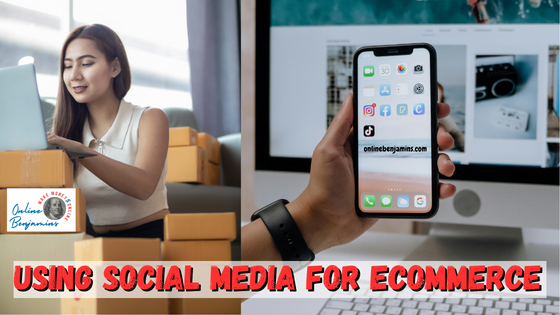We’re going to examine some facts about the undeniable force that is social media in the world of ecommerce. It’s not just about posting pictures and getting likes; it’s about how these platforms are reshaping the way consumers discover and interact with brands.
You might be surprised to find out that with billions of active users globally, social media isn’t just part of the online experience; it’s the heart of digital interaction. And when it comes to shopping, a significant number of people are swayed by what they see on their social media feeds.
QUICK LOOK: Using Social Media for Ecommerce
- Define Your Audience – start by diving into demographics, interests, and the nitty-gritty of what grabs their attention.
- Build Your Brand – adopt a brand voice and a unique value proposition that draws the attention of your target audience so your ecommerce business cuts through the clutter and noise of social media and creates brand awareness.
- Choose the Best Social Platforms – Different social media platforms offer a variety of ad formats, and appeal to different audiences. Knowing which works best for your products and audience is crucial.
- Develop Your Content Calendar – you need to know what to post and when, but also why it matters to your followers. What their hot buttons are, what they are interested in, and why.
- Engage with Your Audience – Think of social media as a two-way street where you can share, listen, and respond to your customers.
- Advertise on Social Media – social media advertising and promotions can act like a magnet, pulling in potential customers and, you can reach a much larger audience in a very short period.
- Analyze Your Results – ongoing analysis and iteration are essential components of your ecommerce social media marketing strategy.
- Adapt and Change where needed – become best friends with adaptability. Engage with your audience often, ask for feedback, and don’t be afraid to pivot your tactics when necessary.
Using social media for ecommerce isn’t just about anecdotal evidence. There are hard numbers that draw a clear line connecting social media presence with increased ecommerce sales. For instance, did you know that certain campaigns on social platforms have led to spikes in sales for some brands, almost overnight?
And if you’re wondering whether this applies to the big players alone, here’s something to consider: small and medium-sized enterprises are also seeing the benefits. They’re using the reach of social media for ecommerce to compete alongside the giants, often with highly targeted and nimble strategies that can adapt on the fly.

Some of the stories that stand out the most are those of brands that have truly embraced social media’s potential, weaving it into the very fabric of their sales and marketing strategies. These are the stories that showcase innovation, community building, and a deep understanding of their audience – elements you’ll learn to harness as read further.
Your social media strategy is not just a checkbox to mark off. It’s your brand’s lifeline on the most bustling virtual streets out there. And getting this strategy right is going to include some critical steps. Let’s tackle them one by one. All businesses, ecommerce or offline, have this in common, they need customers.
In ecommerce, you don’t have a storefront that your potential customers might drive by and notice you. You have to resort to other marketing channels to build your brand awareness, attract customers, and grow your sales and revenue. Using social media for ecommerce has proven to be one of the best channels to accomplish these goals.
But first, you need to identify your audience. You start by diving into demographics, interests, and the nitty-gritty of what grabs their attention. Then begin to sift through the data to pinpoint who’s most likely to swipe their card on your site.
To be effective in using social media for ecommerce you need to adopt a brand voice. A unique value proposition that draws the attention of your target audience so your ecommerce brand cuts through the clutter and noise of social media and creates brand awareness.
Part of building your brand is its visual identity. That’s going to include the right color palette, the fonts, and your logo, ensuring they are uniform and scream ‘you’ across all platforms. Consistency is king.
Then there’s the content calendar – you need to know what to post and when, but also why it matters to your followers. What their hot buttons are, what they are interested in, and why. From special event posts to seasonal promotions, planning ahead is your secret weapon in the war for eyeballs and engagement.
It’s important, however, that you understand this: social media for ecommerce is a marathon, not a sprint. Sure, you can always adjust your approach down the road, but getting off to the right start sets the tempo for your online presence and future sales.
Engaging with your audience on social media isn’t just about posting regularly; it’s about creating a dialogue. Think of social media as a two-way street where you can share, listen, and respond to your customers. Here’s how you can connect with your audience in a way that feels genuine and boosts your ecommerce sales.
Kick things off by crafting interactive content. Polls, quizzes, and contests encourage users to participate and engage. Everyone loves to have their voice heard or to win something, and these types of content make that possible. Reply promptly to all comments to let your audience know that they are important and that they are dealing with real people.

User-generated content (UGC) is a gold mine for ecommerce brands. Encourage your customers to post photos, videos, or reviews of your products. Not only does this provide social proof, but it also deepens customer loyalty and provides you with free, authentic marketing content.
A timely, empathetic customer service response can turn a potential PR nightmare into a customer service win. If you are going to be using social media for ecommerce, make sure your social media team is equipped to handle questions and concerns promptly. Direct messages, comments, and mentions are opportunities to showcase your excellent customer service.
Don’t forget the power of storytelling. Share behind-the-scenes looks, customer stories, product reviews, or the journey of a product from concept to delivery. People love stories; they are more likely to remember and share them than a straightforward product pitch.
When you’re goal is to boost ecommerce sales, social media advertising and promotions can act like a magnet, pulling in potential customers. And, reaching a much larger audience in a very short period. Again, using the demographics and characteristics of your target audience, it’s about connecting the right products with the right people at the right time.

Different social media platforms offer a variety of ad formats, and knowing which works best for your products is crucial. For instance, Instagram Stories are great for lifestyle products while LinkedIn ads may be more suitable for business software. Pinterest, on the other hand, is a very visual-based platform with a majority female audience.
One key to creating successful promotional campaigns is to ensure your ads have clear, irresistible call-to-actions (CTAs). Whether it’s a time-sensitive discount (FOMO) or an exclusive offer, you want to give people a compelling reason to click through and take the desired action.
Remember, though, throwing money at ads without a plan is like trying to hit a bullseye in the dark. It’s important to budget wisely, target your campaigns accurately, and use analytics to track your ROI. This way, you’ll know which ads are working and which to tweak or drop. Otherwise, it can become an expensive disappointment.
However, when you spot patterns in what’s bringing in sales and what’s not, you’re halfway to maximizing your social media strategy’s potential. And that’s going to include making regular updates and experimentation to keep your content fresh and engaging for your audience.
Now I’m going to shoot straight with you, mastering social media is a moving target. What works today might not be the magic formula tomorrow. That’s why ongoing analysis and iteration are essential components of your ecommerce social media marketing strategy. You’re going to find out that adapting to the ebb and flow of social trends can position you for sustained success, and keep you ahead of the competition.
Your first attempt doesn’t need to be your last—it shouldn’t be. Social media platforms are packed with analytics tools that help you understand who is engaging with your content and what’s driving those precious clicks and conversions. Keep a close eye on metrics like reach, impressions, engagement rates, and click-throughs to see how your content stacks up.
In my opinion, A/B testing is a goldmine for insights. Running different versions of your content can shine a light on what resonates with your audience. You might be surprised how a simple tweak to an image or a change in your call-to-action can lead to a significant bump in performance.

Just be aware, that social media is notorious for sudden algorithm changes. Don’t worry too much about it—instead, become best friends with adaptability. Engage with your audience often, ask for feedback, and don’t be afraid to pivot your tactics when necessary. Remember, the brands that stay ahead of the curve aren’t the ones that resist change; they’re the ones that embrace it or initiate it. 😉
So here’s to being nimble and responsive, keeping your finger on the pulse of social media. I hope that you can harness these tips and insights to keep your ecommerce sales surging. After all, every post, every ad, and every interaction is a learning opportunity that can propel your business forward. And that, friends, is how you play the long game in the dynamic landscape of ecommerce sales and social media marketing.
Wishing You Much Success in Your Ecommerce Journey,

- onlinebenjamins.com
- thebeachangler.com
- thesinnerinthemirror.com
- my.wealthyaffiliate.com/rex10
- Facebook: Online Benjamins
- Twitter: @onlinebenjamin1
- Instagram: dotcomdinero
Rex
P.S. If you have any questions or are unsure of anything, I am here and I promise I will get back to you on all of your questions and comments. Just leave them below in the comment section.Follow me on Twitter: @onlinebenjamin1, Instagram: dotcomdinero, and Facebook: Online Benjamins
Hi,
Thanks for stopping by and congratulations for taking the first steps to building your own online business. I’ve been in business both offline and online since 1997. I would consider it an honor to help you build your business. Father of 3, life long outdoorsman with an education in Genetics and Economics. This site is about cutting through the BS and finding the real opportunities in the online world. I look forward to working with you.



